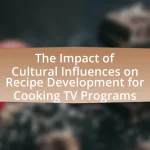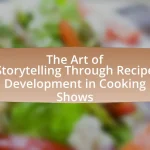Cooking competitions around the world serve as platforms for chefs and culinary enthusiasts to demonstrate their skills, creativity, and techniques, competing for titles and recognition. These events vary in format, from prestigious competitions like the Bocuse d’Or and World Barista Championship to popular televised shows such as “MasterChef” and “Top Chef.” Cultural differences influence the ingredients, techniques, and judging criteria in these competitions, reflecting regional culinary identities. Participants develop essential skills, including time management and creativity, while facing challenges such as high-pressure environments and strict time constraints. The impact of these competitions extends to the culinary industry, fostering innovation and setting new standards in food preparation and presentation.
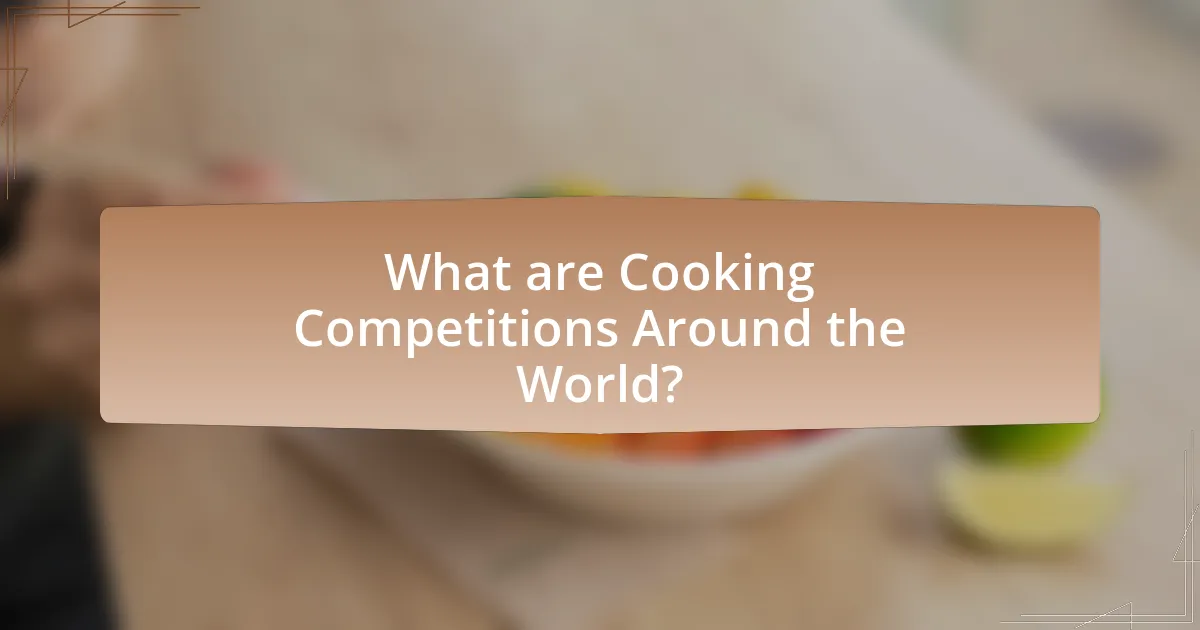
What are Cooking Competitions Around the World?
Cooking competitions around the world are events where chefs and culinary enthusiasts showcase their cooking skills, creativity, and techniques to compete for titles, prizes, or recognition. These competitions vary in format, including televised shows like “MasterChef” and “Top Chef,” as well as local contests such as chili cook-offs and baking championships. Notable examples include the Bocuse d’Or in France, which is considered one of the most prestigious culinary competitions globally, and the World Barista Championship, which highlights excellence in coffee preparation. These events not only promote culinary arts but also foster cultural exchange and innovation in cooking practices.
How do cooking competitions vary by culture?
Cooking competitions vary by culture in terms of ingredients, techniques, judging criteria, and presentation styles. For instance, in Japan, competitions often emphasize precision and seasonal ingredients, reflecting the cultural value placed on harmony and aesthetics in food. In contrast, American cooking competitions may focus on creativity and bold flavors, showcasing a diverse range of culinary influences. Additionally, in France, competitions like the Bocuse d’Or highlight classical techniques and presentation, aligning with the country’s culinary traditions. These cultural differences are rooted in historical practices, regional ingredients, and societal values surrounding food, demonstrating how cooking competitions serve as a reflection of cultural identity.
What are the most popular cooking competitions in different countries?
The most popular cooking competitions in different countries include “MasterChef” in the United Kingdom, “Top Chef” in the United States, “My Kitchen Rules” in Australia, and “Iron Chef” in Japan. “MasterChef,” which originated in the UK in 1990, has been adapted in over 50 countries, showcasing amateur chefs competing for the title. “Top Chef,” launched in 2006, features professional chefs in a high-stakes culinary competition in the US. “My Kitchen Rules,” first aired in 2010, involves home cooks competing in teams to impress judges with their culinary skills in Australia. “Iron Chef,” which began in Japan in 1993, pits chefs against a designated “Iron Chef” in a timed cooking battle, emphasizing creativity and skill. These competitions have gained international acclaim and significantly influenced culinary culture in their respective countries.
How do local ingredients influence competition dishes?
Local ingredients significantly influence competition dishes by enhancing authenticity and showcasing regional flavors. Competitors often utilize locally sourced produce, meats, and spices to create dishes that reflect the culinary heritage of their area, which can resonate with judges and audiences. For instance, in competitions like “Top Chef,” chefs frequently highlight local ingredients to demonstrate their connection to the community and to elevate their dishes’ uniqueness. This practice not only emphasizes freshness but also aligns with trends in sustainable cooking, where the use of local ingredients reduces carbon footprints and supports local economies.
Why are cooking competitions significant in culinary arts?
Cooking competitions are significant in culinary arts because they foster innovation, skill development, and recognition within the industry. These events provide chefs with a platform to showcase their culinary talents, pushing them to experiment with new techniques and ingredients. For instance, competitions like the Bocuse d’Or and World Culinary Cup attract top chefs globally, highlighting culinary excellence and setting industry standards. Additionally, participation in these competitions can lead to career advancements, as winners often gain visibility and opportunities in prestigious restaurants or culinary institutions.
What skills do participants develop through these competitions?
Participants in cooking competitions develop a variety of skills, including culinary techniques, time management, creativity, and teamwork. Culinary techniques are honed through the preparation of diverse dishes under pressure, allowing participants to refine their cooking methods and presentation skills. Time management is critical as competitors must complete their tasks within strict time limits, enhancing their ability to prioritize and execute efficiently. Creativity is fostered as participants are often challenged to innovate and present unique flavor combinations or plating styles. Additionally, teamwork skills are developed in competitions that require collaboration, enabling participants to communicate effectively and work cohesively with others. These skills are essential for success in the culinary field and are validated by the competitive nature of these events, which often mirror real-world culinary challenges faced in professional kitchens.
How do competitions impact the culinary industry?
Competitions significantly impact the culinary industry by fostering innovation and elevating standards among chefs. These events encourage culinary professionals to push their creative boundaries, resulting in new techniques and trends that enhance the overall quality of food preparation and presentation. For instance, competitions like “Top Chef” and “Iron Chef” have popularized unique cooking styles and ingredients, influencing restaurant menus globally. Additionally, winning prestigious culinary competitions can lead to increased visibility and career opportunities for chefs, as evidenced by the rise of many chefs who gained fame and success after participating in such events.
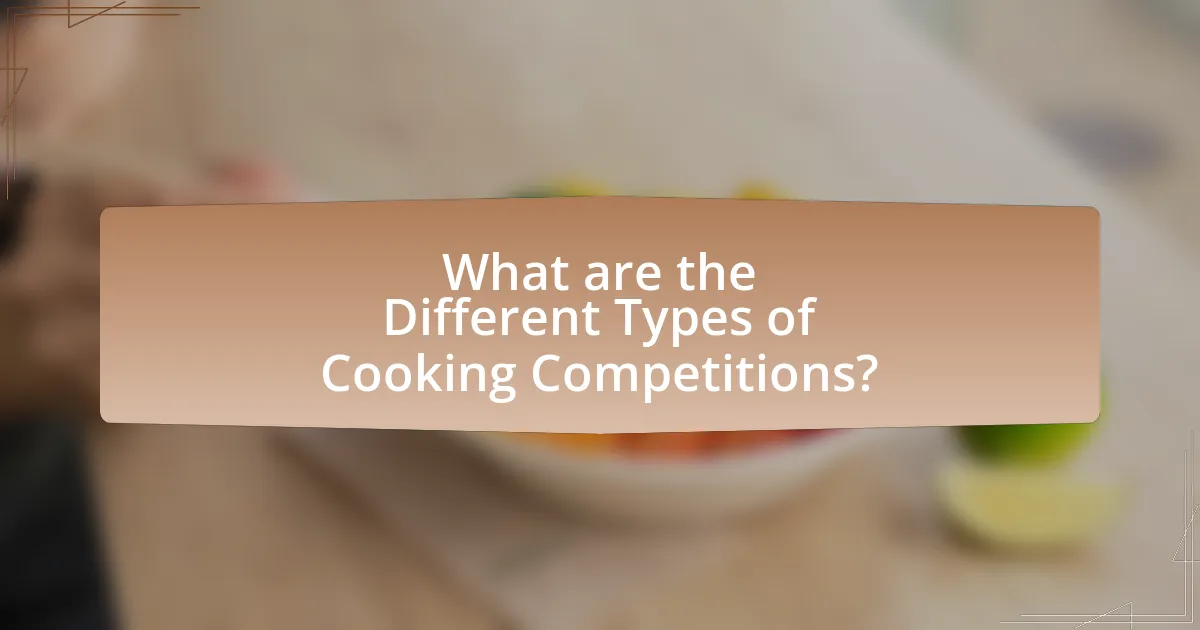
What are the Different Types of Cooking Competitions?
Different types of cooking competitions include professional chef competitions, amateur cooking contests, reality TV cooking shows, and culinary school competitions. Professional chef competitions, such as the Bocuse d’Or, showcase the skills of top chefs from around the world, often judged by industry experts. Amateur cooking contests, like local bake-offs, allow home cooks to demonstrate their culinary talents in a community setting. Reality TV cooking shows, such as “MasterChef” and “Top Chef,” combine entertainment with competition, featuring contestants from various backgrounds competing for a title and prizes. Culinary school competitions, often held between institutions, focus on developing the skills of aspiring chefs and may include events like the SkillsUSA competition. Each type of competition serves to highlight different aspects of culinary arts and fosters creativity and skill development among participants.
How are cooking competitions categorized?
Cooking competitions are categorized primarily by their format, cuisine type, and judging criteria. Formats include individual versus team competitions, live cooking events versus pre-recorded shows, and elimination rounds versus point-based systems. Cuisine types can range from specific regional or national dishes to broader categories like baking or grilling. Judging criteria often focus on taste, presentation, creativity, and adherence to specific themes or requirements. For example, competitions like “MasterChef” emphasize individual skill and creativity, while events like “Iron Chef” focus on speed and adaptability under pressure.
What distinguishes amateur competitions from professional ones?
Amateur competitions differ from professional ones primarily in the level of skill and experience of the participants. Amateur competitors typically have less formal training and may participate for personal enjoyment or community recognition, while professional competitors possess advanced culinary skills, often trained in culinary schools or through extensive experience in the industry.
For instance, professional cooking competitions, such as those sanctioned by the World Association of Chefs Societies, require participants to demonstrate high-level techniques and creativity under strict time constraints, reflecting their professional status. In contrast, amateur competitions, like local bake-offs, focus more on community engagement and personal expression rather than strict adherence to professional standards.
What are the unique formats of televised cooking competitions?
Televised cooking competitions feature unique formats that include elimination rounds, team challenges, and themed episodes. Elimination rounds typically involve contestants competing in individual challenges where the lowest performers are eliminated each week, as seen in shows like “MasterChef.” Team challenges require contestants to work in groups, fostering collaboration and competition, exemplified by “The Amazing Race: Food Edition.” Themed episodes often focus on specific cuisines or cooking techniques, allowing for creativity and specialization, as demonstrated in “Chopped,” where each episode has a unique theme for the mystery basket ingredients. These formats enhance viewer engagement and showcase diverse culinary skills.
What are some notable international cooking competitions?
Some notable international cooking competitions include the Bocuse d’Or, World Culinary Cup, and MasterChef. The Bocuse d’Or, established in 1987 in Lyon, France, is often regarded as the most prestigious culinary competition, featuring chefs from around the world competing for the title. The World Culinary Cup, held in Luxembourg, is one of the largest culinary competitions, showcasing teams from various countries in both hot and cold cooking categories. MasterChef, originating from the UK, has become a global phenomenon with numerous international versions, where amateur chefs compete for the title and a chance to launch their culinary careers. These competitions highlight culinary excellence and innovation on a global scale.
What is the significance of competitions like MasterChef and Top Chef?
Competitions like MasterChef and Top Chef are significant as they elevate culinary arts by showcasing talent and creativity, while also influencing food culture globally. These shows provide aspiring chefs with a platform to gain recognition and advance their careers, evidenced by numerous contestants who have launched successful restaurants or culinary brands post-show. Additionally, they educate audiences about diverse cuisines and cooking techniques, fostering a greater appreciation for gastronomy. The impact of these competitions is reflected in increased viewership and engagement, with MasterChef alone reaching over 100 million viewers worldwide, highlighting their role in popularizing cooking as both an art form and a competitive sport.
How do regional competitions showcase local culinary talent?
Regional competitions showcase local culinary talent by providing a platform for chefs to demonstrate their skills and creativity in front of judges and the public. These events often highlight regional ingredients and traditional cooking methods, allowing participants to express their cultural heritage through food. For example, competitions like the Great British Bake Off or local chili cook-offs emphasize the unique flavors and techniques specific to their areas, fostering community pride and encouraging culinary innovation. Additionally, these competitions can lead to recognition and opportunities for local chefs, as winners often gain visibility that can enhance their careers and promote local cuisine on a broader scale.
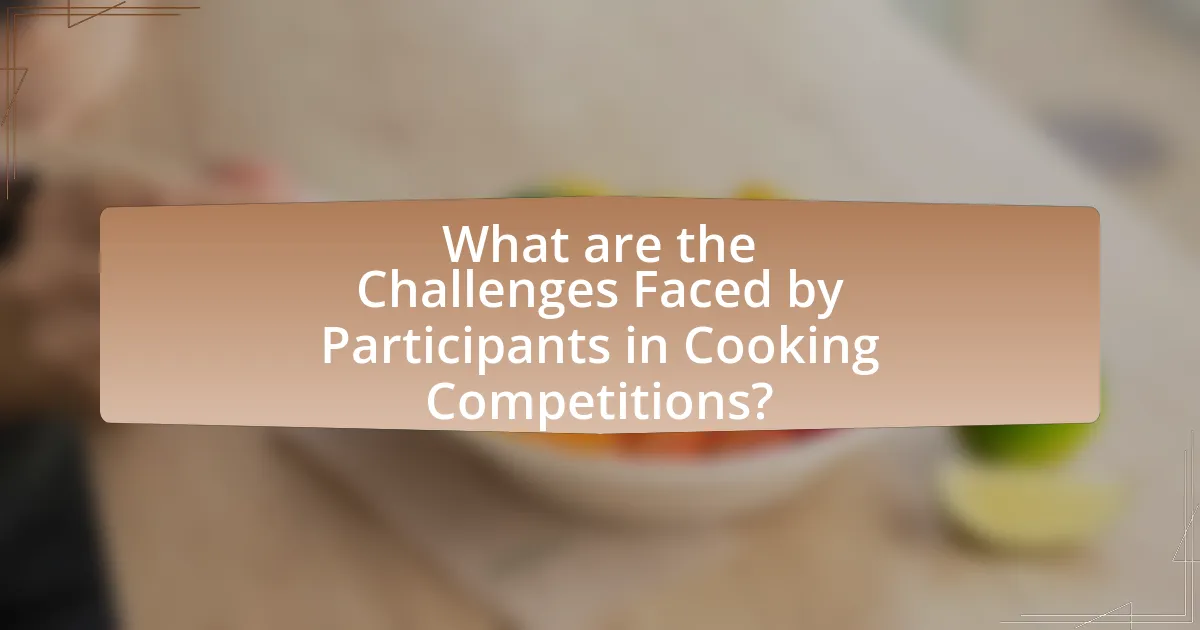
What are the Challenges Faced by Participants in Cooking Competitions?
Participants in cooking competitions face several challenges, including time constraints, high-pressure environments, and the need for creativity under scrutiny. Time constraints often require contestants to prepare complex dishes within limited periods, which can lead to stress and mistakes. The high-pressure environment, amplified by the presence of judges and an audience, can affect performance and decision-making. Additionally, participants must demonstrate creativity and originality while adhering to specific themes or ingredient restrictions, which can be difficult to balance. These challenges are well-documented in various cooking competition formats, highlighting the intense nature of culinary contests globally.
How do time constraints affect cooking performance?
Time constraints significantly impact cooking performance by increasing stress levels and limiting the ability to execute complex techniques. Research indicates that when chefs face tight deadlines, they often prioritize speed over quality, which can lead to mistakes and suboptimal dish presentation. A study published in the Journal of Culinary Science & Technology found that participants under time pressure made 30% more errors in their cooking tasks compared to those with ample time. This demonstrates that while time constraints can enhance efficiency, they can also compromise the overall quality of the culinary output.
What strategies do chefs use to manage time effectively?
Chefs manage time effectively by employing strategies such as mise en place, prioritization of tasks, and multitasking. Mise en place, which means “everything in its place,” involves preparing and organizing ingredients and tools before cooking begins, allowing chefs to work efficiently. Prioritization of tasks helps chefs focus on the most critical components of a dish first, ensuring that everything is completed in a timely manner. Multitasking enables chefs to perform multiple tasks simultaneously, such as cooking and plating, which is essential in high-pressure environments like cooking competitions. These strategies are crucial for success in competitions, where time constraints are strict and the ability to deliver quality dishes quickly can determine the outcome.
How do judges’ expectations influence participants’ choices?
Judges’ expectations significantly influence participants’ choices by shaping their decision-making processes and strategies during competitions. Participants often tailor their dishes to align with the judges’ perceived preferences, which can include specific culinary techniques, flavor profiles, or presentation styles. Research indicates that when judges express particular expectations, such as favoring innovative techniques or traditional recipes, contestants are likely to adjust their approaches accordingly to meet those standards. For instance, a study published in the Journal of Culinary Science found that contestants who were aware of judges’ preferences for creativity were more inclined to experiment with unconventional ingredients, thereby directly impacting their final dish choices.
What role does creativity play in cooking competitions?
Creativity is essential in cooking competitions as it distinguishes participants by showcasing their unique culinary styles and innovative approaches. In these competitions, judges often evaluate dishes not only on taste but also on presentation and originality, making creativity a critical factor for success. For instance, shows like “MasterChef” and “Top Chef” emphasize the importance of inventive recipes and artistic plating, which can significantly influence scoring and advancement in the competition. Thus, creativity serves as a key element that can elevate a contestant’s dish from ordinary to exceptional, directly impacting their chances of winning.
How do competitors balance creativity with technical skills?
Competitors balance creativity with technical skills by integrating innovative ideas with precise culinary techniques. In cooking competitions, participants often showcase their creativity through unique flavor combinations and presentation styles while adhering to fundamental cooking methods and standards. For instance, a competitor may create an avant-garde dish that utilizes molecular gastronomy techniques, demonstrating both artistic vision and mastery of cooking science. This dual focus is essential, as judges typically evaluate dishes based on originality and execution, requiring competitors to excel in both areas to succeed.
What are some examples of innovative dishes created in competitions?
Innovative dishes created in competitions include molecular gastronomy creations like spherified fruit caviar, which was popularized in events such as the World Culinary Cup. Another example is the use of edible flowers and herbs in dishes like the “Garden on a Plate,” showcased in competitions like the Bocuse d’Or. Additionally, fusion dishes, such as sushi burritos, have emerged from culinary contests, blending traditional Japanese sushi with Mexican burrito elements. These examples illustrate the creativity and experimentation that competitions inspire among chefs.
What Tips Can Help Aspiring Chefs Succeed in Cooking Competitions?
Aspiring chefs can succeed in cooking competitions by mastering essential culinary skills, understanding competition rules, and effectively managing time. Mastery of techniques such as knife skills, flavor pairing, and presentation is crucial, as judges often evaluate these aspects rigorously. Familiarity with the specific rules and criteria of each competition allows chefs to tailor their dishes accordingly, increasing their chances of success. Additionally, effective time management during the competition ensures that chefs can complete their dishes without compromising quality. These strategies are supported by numerous successful competitors who emphasize preparation and adaptability as key factors in their achievements.
How can participants prepare effectively for competitions?
Participants can prepare effectively for cooking competitions by mastering essential culinary skills, understanding competition rules, and practicing time management. Mastery of techniques such as knife skills, cooking methods, and flavor pairing is crucial, as these skills directly impact the quality of dishes presented. Familiarity with the specific rules and judging criteria of each competition ensures that participants meet expectations and avoid disqualification. Additionally, practicing time management allows participants to complete their dishes within the allotted time, which is often a critical factor in competition success. According to a study published in the Journal of Culinary Science & Technology, participants who engage in focused practice and simulate competition conditions demonstrate significantly improved performance outcomes.
What common mistakes should competitors avoid?
Competitors in cooking competitions should avoid underestimating the importance of time management. Effective time management is crucial as many competitions have strict time limits, and failing to allocate time wisely can lead to incomplete dishes or rushed presentations. According to a study by the Culinary Institute of America, 70% of culinary students reported that poor time management negatively impacted their performance in practical assessments. This statistic highlights the necessity for competitors to practice and refine their timing skills to ensure they can deliver high-quality dishes within the allotted time.


